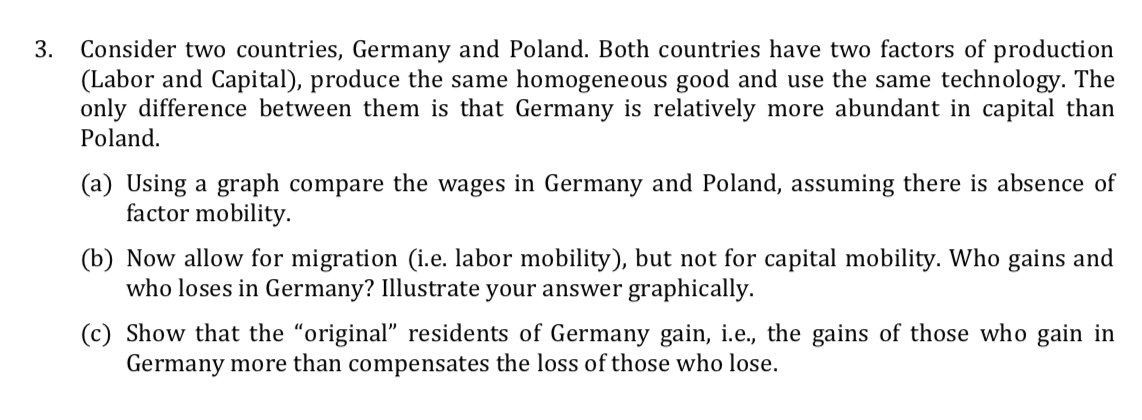Consider two countries, Germany and Poland. Both countries have two factors of production (Labor and Capital), produce the same homogeneous good and use the same technology. The only difference between them is that Germany is relatively more abundant in capital than Poland. 3. (a) Using a graph compare the wages in Germany and Poland, assuming there is absence of factor mobility. (b) Now allow for migration (i.e. labor mobility), but not for capital mobility. Who gains and who loses in Germany? Illustrate your answer graphically. (c) Show that the "original" residents of Germany gain, i.e., the gains of those who gain in Germany more than compensates the loss of those who lose.
Consider two countries, Germany and Poland. Both countries have two factors of production (Labor and Capital), produce the same homogeneous good and use the same technology. The only difference between them is that Germany is relatively more abundant in capital than Poland. 3. (a) Using a graph compare the wages in Germany and Poland, assuming there is absence of factor mobility. (b) Now allow for migration (i.e. labor mobility), but not for capital mobility. Who gains and who loses in Germany? Illustrate your answer graphically. (c) Show that the "original" residents of Germany gain, i.e., the gains of those who gain in Germany more than compensates the loss of those who lose.
Principles of Microeconomics (MindTap Course List)
8th Edition
ISBN:9781305971493
Author:N. Gregory Mankiw
Publisher:N. Gregory Mankiw
Chapter18: The Markets For The Factor Of Production
Section: Chapter Questions
Problem 1CQQ
Related questions
Question

Transcribed Image Text:Consider two countries, Germany and Poland. Both countries have two factors of production
(Labor and Capital), produce the same homogeneous good and use the same technology. The
only difference between them is that Germany is relatively more abundant in capital than
Poland.
3.
(a) Using a graph compare the wages in Germany and Poland, assuming there is absence of
factor mobility.
(b) Now allow for migration (i.e. labor mobility), but not for capital mobility. Who gains and
who loses in Germany? Illustrate your answer graphically.
(c) Show that the "original" residents of Germany gain, i.e., the gains of those who gain in
Germany more than compensates the loss of those who lose.
Expert Solution
This question has been solved!
Explore an expertly crafted, step-by-step solution for a thorough understanding of key concepts.
This is a popular solution!
Trending now
This is a popular solution!
Step by step
Solved in 3 steps with 2 images

Recommended textbooks for you

Principles of Microeconomics (MindTap Course List)
Economics
ISBN:
9781305971493
Author:
N. Gregory Mankiw
Publisher:
Cengage Learning

Principles of Economics (MindTap Course List)
Economics
ISBN:
9781305585126
Author:
N. Gregory Mankiw
Publisher:
Cengage Learning

Principles of Economics 2e
Economics
ISBN:
9781947172364
Author:
Steven A. Greenlaw; David Shapiro
Publisher:
OpenStax

Principles of Microeconomics (MindTap Course List)
Economics
ISBN:
9781305971493
Author:
N. Gregory Mankiw
Publisher:
Cengage Learning

Principles of Economics (MindTap Course List)
Economics
ISBN:
9781305585126
Author:
N. Gregory Mankiw
Publisher:
Cengage Learning

Principles of Economics 2e
Economics
ISBN:
9781947172364
Author:
Steven A. Greenlaw; David Shapiro
Publisher:
OpenStax